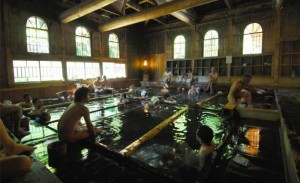 No doubt Walt Whitman would have sounded his barbaric yawp from the steaming rooftop pool of Spa Castle in Queens, had the multi-level Korean day spa been around the corner from his Brooklyn stomping grounds as it is today.
No doubt Walt Whitman would have sounded his barbaric yawp from the steaming rooftop pool of Spa Castle in Queens, had the multi-level Korean day spa been around the corner from his Brooklyn stomping grounds as it is today.
I’m not saying he would have retitled “Song of Myself” to “Song of Ourselves,” but I like to think that he might have been so inclined upon entering the ground-level indoor spa for the first time, onto a wondrous tiled cavern of heated pools, a sauna, steam room and cold plunge, open showers, a dousing shower, and sitting stations to shave or brush one’s teeth—with all manner of naked men roaming from one rite to the next.
(Women have their own identical spa on the ground level, the rest of the floors are unisex and require the oversized, undersexy shirt-and-shorts uniform found in the locker rooms.)
The first time I entered, before I even dipped my toe in the jasmine pool to test the temperature, I was already refreshed by the raw physical diversity that meets the eyes like a democratic antidote to the idolatrous fetishization of body type in today’s culture. Here was every shape and size, from tall to short and skinny to fat, from the comparatively hairless to bearlike monstrosities with throw rugs on their backs and big bushels of pubic hair; from those genetically endowed with a windsock for a penis, to those with a cigar stub.
In keeping with the no-fuss and semi-proletarian style of the place, a distinguishing Eastern feature unlike our more precious Western counterparts, the only question that attends all this anthropological and anatomical diversity is: Who cares?
At Spa Castle, where all the material trappings from the outside world that categorize us vanish in one’s digitized locker, no man is king more or less than any other, and no woman queen.
Recently, while in L.A. for work, a healthy combination of multiple deadlines and environmental road rage led me to Koreatown in search of a West Coast substitute. The subterranean pocket in a strip mall that I settled for was no castle, but it did the trick. It also gave occasion to some fitting meditation on the body in the last weeks of Lent before the dawn of Eastertide.
How is it that a religion like Christianity that stands on the bodily phenomena of the Incarnation and Resurrection, could, theologically speaking, often treat the human body with negligence at best and hostility at worst?
That’s a big question, and one I’m not prepared or qualified to answer here. No doubt a proper response would be a nuanced one filled with indications of the body given its celebratory due in theology. But still, ours is a religion prone to the chronic spiritual typo of “sin” and “skin.”
While most of us may not go to the same extreme as Lactantius, the early Church Father and advisor to Constantine who reviled “this contemptible little body in which we are draped,” all of us have likely struggled at one time and to one degree or another with how to regard our physical selves.
Let’s blame St. Paul, then, seeing what a favorite whipping post he is when it comes to our doctrinal inheritance. (Funny how such a dogmatic brute could be responsible for the most beloved passage on love ever written, read worldwide at weddings on a daily basis.) After all, doesn’t he condemn the body right there in Romans 7:18-19?
For I know that nothing good dwells within me, that is, in my flesh. I can will what is right, but I cannot do it. For I do not do the good I want, but the evil I do not want is what I do.
Well, no. Looks instead like he equates the flesh with the will. Elsewhere he equates the body with the temple of the Holy Spirit. And the Body of Christ—to tautological effect that should have removed any last doubt in the likes of the scholarly Lactantius—with the human body.
Those are some mighty metaphors. But I imagine I’m not alone in that for years I might as well have read that the body is not a temple but a Thermos, a repurposed coffee tin. Then I went back to read about the Temple and the Tabernacle in the Old Testament, about the extravagant glory that informed their design and decor. Like the glory of our own design, by way of Paul’s metaphor—we were “fearfully and wonderfully made” according to the author of Psalm 139.
Much doubt surrounds the provenance of the Gospel of Thomas, and the question of whether it’s a reliable source truly minted in the legacy of its apostolic namesake. But isn’t it fascinating that this infamous text of the Gnostic tradition, a belief system founded upon spiritual disdain for physical imprisonment in a human body, would contain this purported quote from Jesus:
If the body was made for the sake of the spirit, it is a miracle. But if the spirit was made for the sake of the body, it is a miracle of miracles.
While that might open a can of worms about primacy in the Temple-esque structure of our three-part being (spirit, soul and body), I find it hard not to respond with a qualified “Alleluia!” in this season of the Resurrection.
Four years ago my son was born on Good Friday, and when he first latched on to his mother’s breast I stood there amazed once again at what I had learned when our first daughter was born: that the aureole of tiny bumps around the female nipple emit the lingering scent of amniotic fluid from the womb to draw a newborn more by sense memory than by hunger.
Call it a hungry sense of home.
I guess it would make for another post entirely that the amnion has its etymological root in the Greek amnos, meaning “lamb.” Or, at least, an engaging conversation with my son at Spa Castle someday.
Bradford Winters is a screenwriter/producer in television whose work has included such series as Oz, Kings, Boss, and The Americans. His poems have appeared in Sewanee Theological Review, Spoon River Poetry Review, and Georgetown Review, among other journals. He lives in Brooklyn with his wife and three children.














